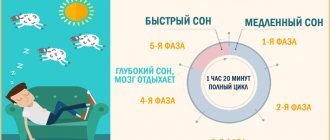- Phases of human sleep: preface
- Phases and stages of sleep
- Diagram of the night cycle by phases and stages of sleep
- Duration of sleep phases and stages
- In what phase is it better to wake up and how to calculate it
- Phases of sleep and dreams
- What happens to us in different stages of sleep
- Interesting features associated with sleep phases
- The importance of sleep phases for the body: a small warning
Many people have heard that sleep consists of successively changing phases and stages . Some people know that in some phases it is easier to wake up, in others it is harder, so ideally, awakening should be adjusted to certain stages of sleep. Someone will say that dreams occur only in one phase (small spoiler - in fact this is not so, see below). In this article, we propose to delve deeper into these and other issues related to different periods of sleep, and consider which phases stand out
, what are their
characteristics and duration , how many phases are needed in order to get enough sleep, and how to independently calculate sleep by phases . In addition, in the last part of the text we will look at how some so-called rational sleep patterns are assessed in terms of phases and stages.
Phases of human sleep: preface
Dreams seem like such an ordinary thing, and yet it is one of those areas that still holds many mysteries. In particular, so far there is no consensus among scientists even regarding whether we see. But the stages and phases of human sleep can be considered fully studied
, including because they are easier to study using various instruments.
The main sources are colored dreams or black and white. data for scientists - the activity of the brain in general and its lobes in particular (shown on the electroencephalogram - EEG), movements of the eyeballs and muscles of the back of the head.
These and a number of other indicators make it possible to draw a more or less clear picture of sleep phase cycles. In general, we propose not to delve into the terms and methods of somnology (the science of sleep), but to consider the phases of sleep on a more practical level: understand how many phases are distinguished, analyze their main features and what distinguishes the phases from each other. This knowledge will help answer questions about which phase is easier to wake up in, how long a healthy sleep should last, etc. But first let's make a few remarks
:
- phases and stages are considered using examples from adults
(with age, the ratio and duration of the phases changes); - for the sake of simplicity and uniformity, periods of sleep will be shown using examples of those who go to bed in the evening
or early at night, rather than in the morning and who do not work at night; - we consider only physiological sleep
- medicinal, hypnotic, etc. are not taken into account in this material; - we will focus on those who are lucky enough to sleep enough hours for their body
and are not forced, for example, to run to the first class after writing a coursework at night.
So, what should normal sleep be like for the average healthy person under such conditions?
The most valuable time for relaxation
On the Internet, a table of the value of sleep is very popular. It reflects the diagram: the first column is the “lights out” time, the second is the corresponding degree of benefit. We present to your attention this interesting theory:
| Sleep start time | Rest value for 1 hour |
| 7-8 pm | = 7 o'clock |
| 8-9 | = 6 |
| 9-10 | = 5 |
| 10-11 | = 4 |
| 11-12 | = 3 |
| 12-1 am | = 2 |
| 1-2 | = 1 |
| 2-3 | = 30 min. |
| 3-4 | = 15 |
| 4-5 | = 7 |
| 5-6 | = 1 |
The information is quite controversial and has received a large number of negative reviews. People are interested in the basis on which such data was generated? Few people can boast of moving “to the side” at 19.00.
One of the comments expressed a more sensible opinion about the value of sleep. Its meaning is that the healthiest, most complete rest is the one that occurs regularly, with a constant time schedule for falling asleep and waking up. Practitioners advise sleeping with this simple method for at least a week.
Phases and stages of sleep
In general, experts divide sleep into two phases:
- Slow sleep , also known as orthodox sleep
, or
NREM sleep
. The name NREM comes from the English Not Rapid Eye Movement and reflects the fact that this phase is not characterized by rapid eye movements. - Rapid eye movement sleep , also known as paradoxical
, or
REM sleep
(that is, rapid eye movements are present). The name “paradoxical” comes from the fact that during this phase of sleep, complete muscle relaxation and high brain activity are combined. It turns out that during this period the brain works almost the same as when awake, but it does not process information received from the senses and does not give orders to the body how to react to this information.
The NREM + REM sleep cycle lasts approximately 1.5-2 hours
(more details below), and during the night these phases successively replace each other.
On average, 3/4 of the cycle
is in slow-wave sleep and, accordingly,
about a quarter
is in fast sleep.
At the same time, slow-wave sleep has a number of stages:
- nap
– transition from wakefulness to sleep; - light sleep
; - moderately deep sleep
; - deep sleep
- it is at this stage that sleep is the deepest.
Stages 3 and 4 are collectively called delta sleep.
, which is associated with the presence of specific delta waves on the EEG.
Causes of poor sleep
Taking a long time to fall asleep, frequent awakenings at night and grogginess in the morning indicate the inadequacy of slow-wave sleep. Of course, the sleep situation can be improved, but first you need to determine the cause of poor sleep. Let's look at the main ones.
- Stress . Conflicts in the family or at work, stressful professional activities, states of shock and other similar factors can worsen the quality of sleep.
- Depression . Long-term depressed mood due to mental disorders is often the cause of insomnia.
- Chronic diseases . First of all, the quality of sleep is affected by hormonal levels in the human body. For example, thyroid pathologies can disrupt sleep. Moreover, endocrine problems may not manifest themselves in any other way.
- Uncomfortable posture during pregnancy . An enlarged abdomen in women during this period interferes with proper sleep. After the 12th week of pregnancy, sleeping comfortably on your side or back becomes more difficult. Therefore, expectant mothers have to adapt to physiological changes. Read about how to sleep during pregnancy here.
Of all the above reasons, stress has the greatest impact on sleep. If a person goes to bed with an unresolved and disturbing problem, sleep difficulties may arise. Anxious thoughts that appear in bed lead to painful and unsuccessful attempts to fall asleep. As a result, the duration of deep sleep is reduced, and in the morning a person feels sleep-deprived and tired.
Insomnia can be diagnosed if difficulty sleeping occurs for more than 5 nights in a row. But isolated and rare sleep disturbances are not classified as insomnia. However, if you cannot get enough sleep for more than 5 days in a row, consult your doctor.
In most cases, poor sleep is associated with frequent stress, moving and significant changes in life.
Diagram of the night cycle by phases and stages of sleep
In terms of sleep cycles, our night goes like this:
- First comes stage 1
slow-wave sleep, which means we move from wakefulness to sleep through drowsiness. - Next, we sequentially go through stages 2, 3 and 4
. Then we move in the reverse order - from delta sleep to light sleep (4 - 3 - 2). - , REM sleep
occurs . Due to the fact that it is the last to be activated in the cycle - after all other stages have passed - it is sometimes called phase 5 or stage 5, which, strictly speaking, is not entirely accurate, because REM sleep is completely different compared to slow wave sleep . - Then we return to stage 2
, and then we again plunge into delta sleep, then light, then fast, then light again... And so the change of phases and stages goes in a circle. Another option is that after REM sleep, awakening occurs.
Emotional disorders and night rest
Sleep and stress are interconnected
People with emotional disorders have difficulty sleeping because they experience increased levels of anxiety and depressive changes. But if you manage to fall asleep quickly, then the quality of sleep may not suffer, although usually the delta sleep phase in these cases is reduced or does not occur at all. Intrasomnic and post-somnic disturbances may additionally appear. If we talk about major depression, patients get up early in the morning and from the very moment of awakening are immersed in their negative thoughts, which reach a maximum in the evening, leading to disruption of the process of falling asleep. As a rule, deep sleep disorders occur together with other symptoms, however, in some patients they may be the only manifestation of the disease.
There is another category of patients who experience the opposite problem - the initial stages of slow-wave sleep can occur during wakefulness, leading to the development of hypersomnia, when a person constantly notes high drowsiness and can fall asleep in the most inappropriate place. If this condition is hereditary, a diagnosis of narcolepsy is made, which requires special therapy.
Duration of sleep phases and stages
As we said above, the entire sleep cycle (slow and fast sleep) takes on average about 1.5 hours to 2 hours. At the same time, the duration of phases and stages and their ratio within one cycle changes over the course of the night. Let's look at how the phases are distributed on average and how long each of them lasts.
- The usual duration of stage 1
(napping) is 5-15 minutes. If a person falls asleep only with his head on the pillow, this indicates that he needs to go to bed earlier, sleep more, or, in principle, rest more. - During the night, about 50% of sleep is light sleep
- this is slow-wave sleep, but not in its deepest manifestations. The average duration of one “portion” of such sleep is about 20 minutes. - When we just fall asleep, the duration of deep and moderately deep sleep (delta sleep)
is longer than in the morning. During the first cycle, delta sleep can take up to 40 minutes, and in subsequent cycles this figure decreases. In total, stages 3 and 4 occupy 15-20% of all sleep during the night. - For REM
and light sleep, respectively, the opposite is true: these periods are longest close to the morning. The duration of REM sleep at the beginning of the night is very short (in the first cycle - 5-10 minutes), and then increases to 30-40 minutes, and sometimes more. In total, REM sleep accounts for about a quarter of the total time during the night.
Thus, in the first cycle, full-fledged deep sleep (stage 4) occurs approximately 40-50 minutes after sleep
, and fast -
after 1.5 hours
. Based on the average need for sleep, we find that in a normal state a person needs to sleep 3-6 cycles per night - depending on their duration and his need for sleep. In turn, this need varies greatly: some need 4 hours, for some the norm may exceed 10 hours.
Sleep duration according to age
Science has proven that the average sleep duration for a healthy adult is 8 hours. Some experts talk about 9 hours. However, depending on the age of the person, these figures differ significantly.
- Newborns spend 18 to 20 hours asleep.
- Children aged one to three years – 14 hours.
- Preschool children (up to 5 years old) need 10-12 hours.
- Primary school children need 9-10 hours for full recovery.
- Teenagers - 8-10 hours.
- Elderly people - 7-8 hours.
Often the required duration of sleep varies from person to person. Napoleon needed 4 hours, and Einstein needed 12 hours.
In what phase is it better to wake up and how to calculate it
As you know, it is easiest to wake up during REM sleep.
, in second place is the lung stage. Knowing the sequence of different periods, you can guess the optimal time to wake up. On the other hand, we must take into account that the duration of the phases varies from person to person; in addition, the need for one or another “type” of sleep varies depending on the state. For example, if you are tired, sick, or recovering from an illness, slow-wave sleep may take longer.
Of course, to make it easier for you to wake up, you can buy various gadgets that read the characteristic features of the phases (more details below) and wake you up.
you exactly at the right time.
But you can find out how to wake up during REM sleep on your own - first of all, you need to experiment
. For example, take 2 hours as a sleep phase, calculate what time you need to go to bed/wake up in order to withstand a whole number of cycles. For example, if you have to get up at 8 am, the multiples of the phases would be 6 am, 4 am, 2 am, midnight, etc. When calculating the time, take into account the fact that you will need a little more time to fall asleep. As we said, Stage 1 usually takes 5-15 minutes. That is, to get up at 8, you need to go to bed at 1:45 or 23:45.
Try following this schedule for a while and see if you are able to wake up during REM sleep. If not, “play” with the boundaries - make a calculation based on 1 hour 50 minutes or 1 hour 40 minutes. This way you can find exactly your duration of the night cycle and then build on it. It is best to conduct experiments when you are in a normal physical and emotional state and have had more or less normal sleep on the eve of the experiments.
In addition, we recommend that you read our article “How to Wake Up Without an Alarm Clock.”
We also hint that by “go to bed” we mean exactly go to bed, and not “lie in bed with a smartphone in your arms and chat in instant messengers for another hour.” Let us also note that calculating sleep phases will not give you vigor if you have been sleeping only one cycle per night for a week. Adjusting to the phases is a tool for waking up easier, but it will not free you from the need to fully sleep.
Helpful Tips: How to Benefit from a Night's Sleep
Regardless of whether a man or woman has a disturbed sleep structure, or how much a person sleeps, if he does it incorrectly, then rest will not give the desired result. To improve its quality, you need to follow the following recommendations from experts:
- Stick to a bedtime schedule. It is better to go to bed no later than 11 pm. At the same time, it is advisable to wake up no earlier than 7 am (this indicator varies from person to person).
- Before going to bed, you need to ventilate the room. The temperature in the bedroom should not exceed 22 degrees. To improve your sleep quality, you can take an evening walk in the fresh air.
- A few hours before rest, you should not eat food that requires a long digestion time. As a last resort, you can drink a glass of warm milk.
- Night rest should include the period after midnight to 5 am.
- Drinking coffee, strong tea or alcohol in the evening is strictly prohibited.
- If a person has difficulty falling asleep, he can drink tea using soothing herbs (motherwort, valerian), or take a relaxing bath with sea salt. Aromatherapy often helps you fall asleep.
- It is important to choose a comfortable resting position.
- Preference should be given to orthopedic devices for rest. The mattress should be flat and hard. Do not use a high headboard.
- The room should be quiet and dark at night.
- After waking up, it is better to take a contrast shower or do light exercises.
A proper night's rest, respecting its structure, is the key to good health and well-being. A person wakes up rested, productive, and in a great mood. Systematic lack of sleep will lead to serious impairments in the functionality of the body, which are not easy to get rid of.
Phases of sleep and dreams
According to research, it is wrong to ask the question: “In what phase of sleep do you dream?” A more correct formulation would be: “Dreams from which phase do we remember best?” Research shows that we dream at all stages
– even at the stage of deep sleep. Another thing is that we do not remember them - perhaps due to the fact that slow-wave sleep is too deep and brain activity is lower. However, we do not always remember even what we saw in the REM sleep phase. Read more about this in our article “Interesting facts about dreams.”
Paradoxical phase behavioral disorder
Research results have shown that sleep disturbance occurs mainly in older men. Causes include: post-traumatic stress, apnea, narcolepsy, high blood pressure. Dissociative disorders affect nocturnal motor activity.
During the transition to the paradoxical phase, nocturnal paroxysmal dystonia may occur. Manifests itself in nightmares, somnambulism, and “sleepwalking.” During a medical examination, there are no special pathologies in this case. At the first symptoms of these disorders, consultation with a neurologist and psychiatrist is necessary.
What happens to us in different stages of sleep
One of the main differences between the phases is different brain activity
, which can be visually traced in the waves on the EEG, but the physiology of the sleep phases is characterized not only by this. Another distinction between fast and slow is reflected in the English names REM and NREM - the presence and absence of rapid eye movements. In general, determining the sleep phase by eye, without taking into account instruments and measuring various indicators, is quite problematic. We can only say that if a person moves his eyes, limbs, etc., most likely we are talking about REM sleep. What can be registered on various devices? Here are some interesting facts.
Traits of slow-wave sleep
To plunge into the first stage of slow-wave sleep (drowsiness), the brain produces special substances that block its activity, cause lethargy, and also affect other body systems, including slowing down metabolism
. In stages 2-4, especially during delta sleep, metabolism also slows down.
To say that during slow-wave sleep there is basically no eye movement
, not entirely true - they are present in stages 1 (drowsiness) and
2 (light sleep), but specifically slow;
in English terminology they are called slow rolling eye movement (SREM). In turn, during delta sleep there are not even such movements, but it is in this phase that people walk or talk in their sleep, and also perform other uncontrolled actions, if this is typical for them. In the slow-wave sleep phase, body temperature drops by 1-1.5 degrees (especially in deep sleep), pulse and blood pressure decrease, and breathing becomes rarer. At the same time, growth hormones, sex hormones, etc. are more actively produced, tissue building processes, etc. are underway. This is why they say that slow-wave sleep is largely responsible for physiological rest.
. In addition, this phase is necessary for the restoration of brain tissue after wakefulness (more about this in the first video of our article “Don’t deny yourself sleep”).
Traits of REM sleep
One of the main features of REM sleep is the most vivid dreams.
. By the words “the most vivid” we mean that almost all the dreams that we remember after waking up are from this phase. It is believed that REM sleep, in turn, is responsible for processing information received during the day, internal work on emotions, etc. But so far scientists cannot say exactly how exactly what happens during REM sleep and what mechanisms are involved.
As we have already noted, visual REM sleep
can be recognized by the movements of the eyeballs, sometimes ragged breathing, hand movements, etc. This phase is also characterized by changes in body temperature and heart rate: they can increase or decrease within the same stage.
Interestingly, brain activity
during REM sleep is so high that scientists for a long time could not notice the difference on the EEG between this phase of sleep and wakefulness. True, to date several important differences have been found.
Interesting features associated with sleep phases
Any phase is characterized by a distorted idea of time
. Probably everyone is familiar with situations when you close your eyes for a minute and 5 hours are gone. The opposite is also true: it seemed like the whole night had passed and I had a lot of dreams, but in fact only 20 minutes had passed.
Some people believe that during sleep a person is completely disconnected from reality.
, however, in reality this is not the case.
Many signals are indeed not properly processed by the brain, especially during delta sleep, but during REM sleep, sounds become the main source of information. For example, we are not always awakened by noise, but a person can wake up from the fact that someone even quietly calls his name. Also, during REM sleep, sounds can be integrated into the dream and become part of it. This suggests that the brain processes sounds
during sleep and decides which ones to pay attention to and how to do it.
In children, the proportion of REM sleep is greater than in adults, and in older people it is even less. That is, the older we get, the shorter the paradoxical phase
sleep and longer orthodox. Interestingly, REM sleep is observed even in children in the womb. Scientists say that in the early stages of life (including before birth), REM sleep is very important for the formation of the central nervous system.
Research shows the brain may not be able to submerge
entirely in the same phase, which is especially characteristic of delta sleep. Although most of the brain is usually at the same stage.
REM sleep
REM sleep is classified as the fifth stage of sleep. At this time, the state of the sleeper is as active as possible. But, despite this, his muscles are paralyzed and the person is in one position. The subconscious mind works well enough that you can remember all your dreams.
If you wake up a sleeper during the fast phase, he will be able to tell all his dreams in the most colorful and vivid detail.
At the fourth stage, it is quite difficult to wake up on your own. If you try to wake a sleeping person, you will need more effort. Some experts note that a sharp transition from such a period to wakefulness can negatively affect the psyche. REM sleep takes about 60 minutes.
Adequate sleep is essential for all people, because it helps maintain strong nerves, high immunity, and even an optimistic outlook on the world around us.
The importance of sleep phases for the body: a small warning
It is impossible to say which sleep is better or more useful - fast or slow. Both phases are needed for proper rest and recovery.
the body both at the physiological and mental levels.
In this regard, questions arise about sleep patterns in which there is no full cycle. Surely many have heard about schemes that suggest that a person sleeps not once a day for 6-8 hours, but several times during the day. Some of these schemes seem quite harmless, but the benefits of others are seriously questionable.
In particular, there is information on the Internet about a supposedly very effective schedule when you need to sleep 6 times for 20 minutes or 4 times for 30 minutes. Based on a typical sleep cycle, these time periods are very short, and in 20-30 minutes a person will not have time to move beyond stages 2-3, that is, we are not talking about deep and REM sleep in principle. Meanwhile, the most important processes for our body occur precisely at these stages. It is possible that people who are described as having success with such regimens have very compressed sleep cycles, but there is a good chance that the reality is simply embellished for the sake of an impressive story.
Of course, for some time the average person’s body will function on 20 minutes 6 times a day. It may even seem to him that he has begun to spend his time more efficiently, but the benefits of these schemes for the body in this case raise questions. A systemic lack of sleep affects both mental and physical health and leads to various unpleasant consequences. Without denying the benefits and effectiveness of other rational sleep patterns, we urge you to consult your doctor and be very wary of options that do not include at least several full cycles per day.
Changes in the body
The norm for deep sleep for an adult and a child is about 30% of the total night's rest. During delta sleep, significant changes occur in the functioning of internal organs: the heart rate and breathing rate become lower, and skeletal muscles relax. There are few or no involuntary movements. It is almost impossible to wake a person - to do this you need to call him very loudly or shake him.
According to the latest scientific data, it is during the deep sleep phase that normalization of metabolic processes and active restoration occur in the tissues and cells of the body, allowing the internal organs and brain to be prepared for a new period of wakefulness. If you increase the ratio of REM sleep to slow-wave sleep, the person will feel unwell, experience muscle weakness, etc.
The second most important function of the delta period is the transition of information from short-term memory to long-term memory. This process occurs in a special structure of the brain - the hippocampus, and takes several hours. With chronic disturbance of night rest, people experience an increase in the number of errors when testing the efficiency of memory, speed of thinking and other mental functions. In this regard, it becomes clear that it is necessary to get enough sleep and ensure a good night's rest.











